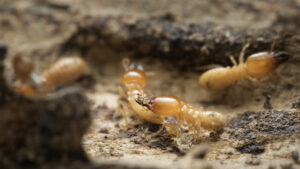Breakthrough leach tests validate Haranga Resources’ uranium prospects

Uranium extraction rates at Haranga are in line with existing operations. Pic: Getty Images
- Test work shows Saraya uranium extraction rates in line with peers, Haranga Resources says
- Low acid extraction rates still rising at end of test with >90% uranium calculated after 59 hours
- Additionally, uranium extractions generated by both acid and alkaline conditions were industry comparable
- This provides process optimisation options for both routes
Special Report: The prospectivity of Haranga Resources’ Saraya uranium project has received a shot in the arm after test work confirmed that uranium could be leached at rates consistent with other projects.
The company has been going all out exploring the project and the results have validated its efforts.
Auger drilling to follow-up on termite mound sampling has thus far proved that the sampling material evacuated by termite digging deep into the earth to build their nests is a cost effective method of identifying uranium anomalies.
Of the 91 new auger holes drilled and assayed by Haranga Resources (ASX:HAR) at the Sanela prospect, 29 have recorded significant portable XRF readings of between 14ppm and 81ppm uranium in saprolite samples.
While pXRF is no replacement for laboratory assaying, the results have proved the viability of Saraya’s prospectivity by locating uranium anomalies below the blanketing laterite.
To top it off, Sanela is just the first of 10 termite anomalies that will be subject to intense auger coverage.
Saraya already has an inferred resource of 12.45Mt grading 587 parts per million eU3O8 for 16.1Mlbs of contained U3O8.
Industry standard uranium extraction
Initial sighter leach test work on composite drill core from Saraya has now added further to the project’s potential.
The first test at an excess sulphidic addition rate of 681kg/t and elevated temperatures (95 degrees C) achieved >96% uranium oxide, which exceeds other uranium operations.
A follow-up test with reduced acid consumptions also returned strong results, achieving uranium extraction of 84% after dropping the acid addition rate to 224kg/t with the test finding that recoveries could hit 90% with additional retention time.
Meanwhile, an alkaline leach test conducted at elevated temperature achieved a similar uranium extraction (84%) as the low acid test.
Leach kinetics were lower with extracted uranium oxide values still increasing in the 24 hour sub-sample.
“These further results from the ore characterisation testwork are very positive. The initial, aggressive, testwork had already proven that the uranium mineralisation within the Company’s Saraya deposit was leachable,” managing director Peter Batten said.
“This next round of tests was undertaken to determine if the leach rates at industry standard concentrations and conditions were consistent with existing uranium operations.
“Uranium recoveries are in line with industry standards from both acid and alkaline routes and provide further scope to optimise extractions using both routes and determine which method is likely to provide optimum project economics.
“Both low acid and alkaline leach recoveries were 84%, similar to other uranium late stage development projects and operations and gives Haranga two options to consider when we approach any feasibility studies for the Saraya Uranium Deposit.”
Testing recommendations and other work
Independent Metallurgical Operations (IMO), which supervised the initial test work, recommended that further beneficiation test work be conducted to determine if acid consuming carbonate minerals can be removed to further reduce acid addition rates whilst still maintaining uranium extraction rates.
Further test work at increased reaction times and progressively reducing temperature is also recommended to determine minimum temperature required to achieved industry standard uranium extractions.
Optimisation of the alkaline test work is likely to involve either decreasing the grind size or varying reagent and leach conditions to increase extractions.
Further work may include a detailed mineralogical investigation to determine uranium mineral and liberation properties, particularly association with carbonate minerals and liberation size.
Fieldwork – including termite mound sampling and auger drilling – is also continuing in Senegal.
This article was developed in collaboration with Haranga Resources, a Stockhead advertiser at the time of publishing.
This article does not constitute financial product advice. You should consider obtaining independent advice before making any financial decisions.
Related Topics

UNLOCK INSIGHTS
Discover the untold stories of emerging ASX stocks.
Daily news and expert analysis, it's free to subscribe.
By proceeding, you confirm you understand that we handle personal information in accordance with our Privacy Policy.








